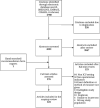A scoping review of registry captured indicators for evaluating quality of critical care in ICU
- PMID: 34353360
- PMCID: PMC8339165
- DOI: 10.1186/s40560-021-00556-6
A scoping review of registry captured indicators for evaluating quality of critical care in ICU
Abstract
Background: Excess morbidity and mortality following critical illness is increasingly attributed to potentially avoidable complications occurring as a result of complex ICU management (Berenholtz et al., J Crit Care 17:1-2, 2002; De Vos et al., J Crit Care 22:267-74, 2007; Zimmerman J Crit Care 1:12-5, 2002). Routine measurement of quality indicators (QIs) through an Electronic Health Record (EHR) or registries are increasingly used to benchmark care and evaluate improvement interventions. However, existing indicators of quality for intensive care are derived almost exclusively from relatively narrow subsets of ICU patients from high-income healthcare systems. The aim of this scoping review is to systematically review the literature on QIs for evaluating critical care, identify QIs, map their definitions, evidence base, and describe the variances in measurement, and both the reported advantages and challenges of implementation.
Method: We searched MEDLINE, EMBASE, CINAHL, and the Cochrane libraries from the earliest available date through to January 2019. To increase the sensitivity of the search, grey literature and reference lists were reviewed. Minimum inclusion criteria were a description of one or more QIs designed to evaluate care for patients in ICU captured through a registry platform or EHR adapted for quality of care surveillance.
Results: The search identified 4780 citations. Review of abstracts led to retrieval of 276 full-text articles, of which 123 articles were accepted. Fifty-one unique QIs in ICU were classified using the three components of health care quality proposed by the High Quality Health Systems (HQSS) framework. Adverse events including hospital acquired infections (13.7%), hospital processes (54.9%), and outcomes (31.4%) were the most common QIs identified. Patient reported outcome QIs accounted for less than 6%. Barriers to the implementation of QIs were described in 35.7% of articles and divided into operational barriers (51%) and acceptability barriers (49%).
Conclusions: Despite the complexity and risk associated with ICU care, there are only a small number of operational indicators used. Future selection of QIs would benefit from a stakeholder-driven approach, whereby the values of patients and communities and the priorities for actionable improvement as perceived by healthcare providers are prioritized and include greater focus on measuring discriminable processes of care.
Keywords: Benchmarking; Critical illness; Health system improvement; ICU; Patient safety; Quality indicators.
© 2021. The Author(s).
Conflict of interest statement
AB and RH are funded by Wellcome Oxford CRIT Care Asia.
Figures
References
-
- Dewan Y, Komolafe EO, Mejía-Mantilla JH, Perel P, Roberts I, Shakur H. CRASH-3-tranexamic acid for the treatment of significant traumatic brain injury: study protocol for an international randomized, double-blind, placebo-controlled trial. Trials. 2012;13(1):1–4. doi: 10.1186/1745-6215-13-87. - DOI - PMC - PubMed
-
- Myles P, Bellomo R, Corcoran T, Forbes A, Wallace S, Peyton P, Christophi C, Story D, Leslie K, Serpell J, McGuinness S. Restrictive versus liberal fluid therapy in major abdominal surgery (RELIEF): rationale and design for a multicentre randomised trial. BMJ Open. 2017;7(3):e015358. doi: 10.1136/bmjopen-2016-015358. - DOI - PMC - PubMed
-
- Angus DC, Berry S, Lewis RJ, Al-Beidh F, Arabi Y, van Bentum-Puijk W, Bhimani Z, Bonten M, Broglio K, Brunkhorst F, Cheng AC. The REMAP-CAP (randomized embedded multifactorial adaptive platform for community-acquired pneumonia) study. Rationale and design. Ann Am Thorac Soc. 2020;17(7):879–891. doi: 10.1513/AnnalsATS.202003-192SD. - DOI - PMC - PubMed
Publication types
Grants and funding
LinkOut - more resources
Full Text Sources



